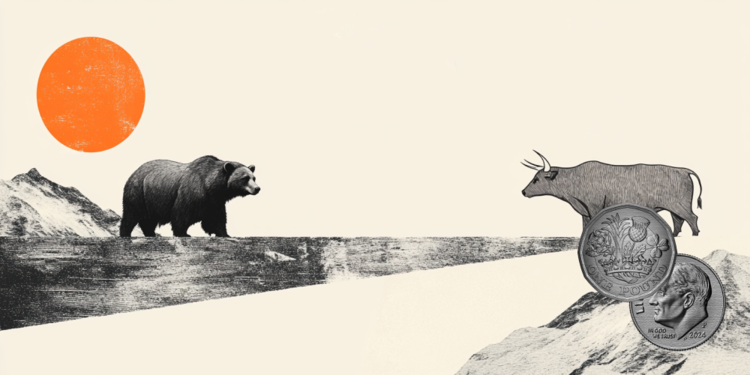- USD/CAD bulls remain on the defensive amid a modest USD pullback from a two-month high.
- Expectations of a less aggressive policy from the Fed limit the losses of the USD and the pair.
- Bets on a further BoC rate cut and weak crude oil prices could also offer support to the pair.
The USD/CAD pair struggles to capitalize on a modest rally in the Asian session on Wednesday and remains below its highest level since August 6, around the 1.3835-1.3840 region touched the previous day. Spot prices are currently trading around the 1.3775 region, almost unchanged on the day, although the fundamental backdrop supports prospects for an extension of the recent strong rally seen over the past three weeks or so.
The US Dollar (USD) weakens from a more than two-month high touched earlier this week and turns out to be a key factor acting as a headwind for the USD/CAD pair. That said, any significant USD correction still appears elusive amid growing expectations of less aggressive easing policy by the Federal Reserve (Fed) and a regular 25 basis point (bp) interest rate cut in November. In addition to this, bets on a further 50bp rate cut by the Bank of Canada, driven by softer domestic consumer inflation figures, could continue to weigh on the Canadian Dollar (CAD) and offer some support to the pair. foreign exchange.
A Statistics Canada report released Tuesday showed the headline Consumer Price Index (CPI) contracted 0.4% in September and the annual rate slowed from 2.0% in August to 1.6%. This marks the smallest annual increase since February 2021 and raises hopes of a bigger-than-usual BoC rate cut next week. Additionally, a bearish sentiment around crude oil prices, driven by easing fears of supply disruptions from the Middle East, could weaken the commodity-linked Loonie. This, in turn, validates the positive outlook for the USD/CAD pair and suggests that the path of least resistance remains to the upside.
Even from a technical perspective, the Relative Strength Index (RSI) weakened from slightly overbought conditions on the daily chart and supports the prospects of some buying emerging at lower levels. Therefore, it will be prudent to wait for strong follow-through selling before confirming that the USD/CAD pair has peaked in the near term and positioning for any significant correction. Traders now await the Canadian economic agenda, which includes the release of manufacturing sales and housing starts. In addition to this, the dynamics of the USD and crude oil prices should provide some boost to the currency pair.
The Canadian Dollar FAQs
The key factors that determine the price of the Canadian Dollar (CAD) are the level of interest rates set by the Bank of Canada (BoC), the price of oil, Canada’s main export product, the health of its economy, inflation and the trade balance, which is the difference between the value of Canadian exports and its imports. Other factors are market confidence, that is, whether investors bet on riskier assets (risk-on) or look for safe assets (risk-off), with the risk-on being positive for the CAD. As its largest trading partner, the health of the US economy is also a key factor influencing the Canadian dollar.
The Bank of Canada (BoC) exerts significant influence over the Canadian Dollar by setting the level of interest rates that banks can lend to each other. This influences the level of interest rates for everyone. The BoC’s main objective is to keep inflation between 1% and 3% by adjusting interest rates up or down. Relatively high interest rates are usually positive for the CAD. The Bank of Canada can also use quantitative easing and tightening to influence credit conditions, with the former being negative for the CAD and the latter being positive for the CAD.
The price of oil is a key factor influencing the value of the Canadian Dollar. Oil is Canada’s largest export, so the price of oil tends to have an immediate impact on the value of the CAD. Generally, if the price of oil rises, the CAD also rises, as aggregate demand for the currency increases. The opposite occurs if the price of oil falls. Higher oil prices also tend to lead to a higher probability of a positive trade balance, which also supports the CAD.
Although inflation has traditionally always been considered a negative factor for a currency, as it reduces the value of money, the opposite has actually happened in modern times, with the relaxation of cross-border capital controls. Higher inflation often leads central banks to raise interest rates, attracting more capital inflows from global investors looking for a lucrative place to store their money. This increases the demand for the local currency, which in the case of Canada is the Canadian Dollar.
The published macroeconomic data measures the health of the economy and may have an impact on the Canadian dollar. Indicators such as GDP, manufacturing and services PMIs, employment and consumer confidence surveys can influence the direction of the CAD. A strong economy is good for the Canadian dollar. Not only does it attract more foreign investment, but it may encourage the Bank of Canada to raise interest rates, resulting in a stronger currency. However, if economic data is weak, the CAD is likely to fall.
Source: Fx Street
I am Joshua Winder, a senior-level journalist and editor at World Stock Market. I specialize in covering news related to the stock market and economic trends. With more than 8 years of experience in this field, I have become an expert in financial reporting.







